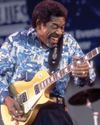
GT: What is it about guitar instrumentals in particular that appeals to you?
SH: They feature the guitar! I was about 10 years old when these erupted into being and they are a big part of the reason why I play the guitar in the first place. What’s not to like about them? The way this form of music has developed fascinates me. I’ve been allowed to develop my own style to incorporate my writing and recordings and so to release massive amounts of tracks that retell and continue molding what are guitar instrumentals. It’s just fundamental to me, although, since it’s lost its pop-chart-hit sensibility I guess millions of folk don’t truly know of its existence or relevance to the guitar story.
GT: What is it that an instrumental tune can provide the listener that a vocal song can’t?
SH: Escapism from vocals! The voice is the most pleasing sound to us, but all instrumental music thinks millions of classical compositions - soothe our ears without the division or selectiveness that voices require. Liking a voice is normal but quite a finite choice, while instrumental music allows more ebb and flow, fewer decisions about interpretation and meaning so allows greater expanse of freedom from definition.
GT: Are there any tendencies with instrumentals that you aim to embrace or avoid (rhythms, harmony, playing approach, tones)?
هذه القصة مأخوذة من طبعة November 2020 من Guitar Techniques.
ابدأ النسخة التجريبية المجانية من Magzter GOLD لمدة 7 أيام للوصول إلى آلاف القصص المتميزة المنسقة وأكثر من 9,000 مجلة وصحيفة.
بالفعل مشترك ? تسجيل الدخول
هذه القصة مأخوذة من طبعة November 2020 من Guitar Techniques.
ابدأ النسخة التجريبية المجانية من Magzter GOLD لمدة 7 أيام للوصول إلى آلاف القصص المتميزة المنسقة وأكثر من 9,000 مجلة وصحيفة.
بالفعل مشترك? تسجيل الدخول

THE MOODY BLUES
This month Stuart Ryan delves into the picking style of this British prog legend whose acoustic guitar has powered many a Moody Blues song.

WAYNE KRANTZ
This issue Nick Mellor provides an insight into this brilliant jazz stylist, focusing on his approach to improvising over static chords.

OPEN G TUNING
Open tunings are great fun and can help create exciting new ideas. Simon Barnard shows how to incorporate open G tuning into your playing.

RODRIGO GOUVEIA
Last month we featured Mateus Asato, and mentioned the importance of the neo-soul style in his playing. Here we turn to his fellow Brazilian, the master of neo-soul fusion.

MARK KNOPFLER
Our topic this month is a master craftsman as both guitar player and songwriter. His style is unique and his influence spreads far and wide.

U2
Martin Cooper checks out the chiming pedal delay tones of this stadium-filling band from Dublin, Ireland, and guitarist The Edge.

LUTHER ALLISON
It’s blues with a touch of soul this month, as David Gerrish explores the dynamic, expressive style of an often overlooked Chicago bluesman.

JOHANN KASPAR MERTZ Capriccio
This month Declan Zapala explores the music of Austria at the turn of the Romantic period with a fiery caprice to level up your fingers and unlock your inner virtuoso.

THE CROSSROADS Michael Landau
John Wheatcroft explores the playing of a session ace _ and blazing blues-rock maestro who graces the top-flight m band of singer-songwriting legend, James Taylor.

VIDEO MASTERCLASS Troy Redfern
This month GT welcomes this slide guitar virtuoso. If you've been wanting to take your slide playing to the next level then this is one's for you. With Jon Bishop.